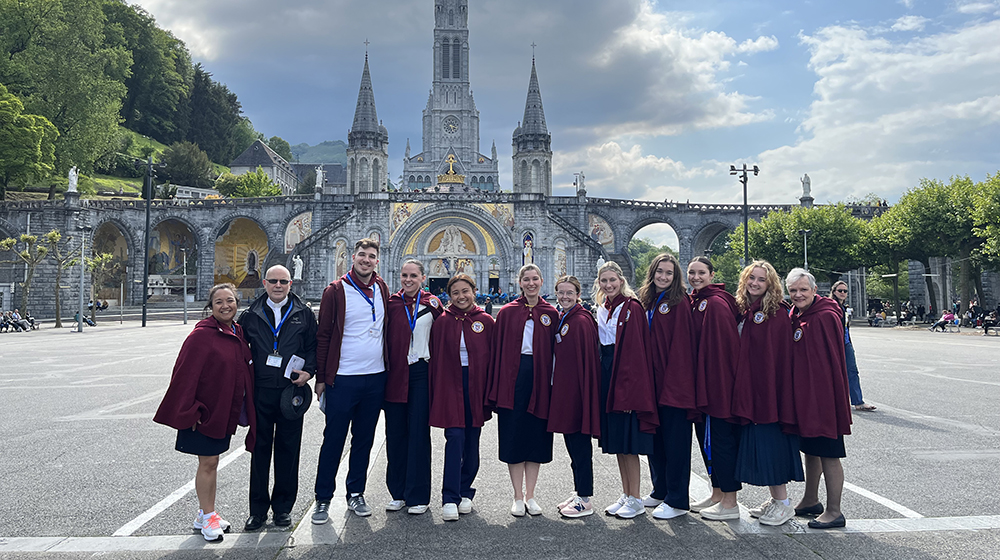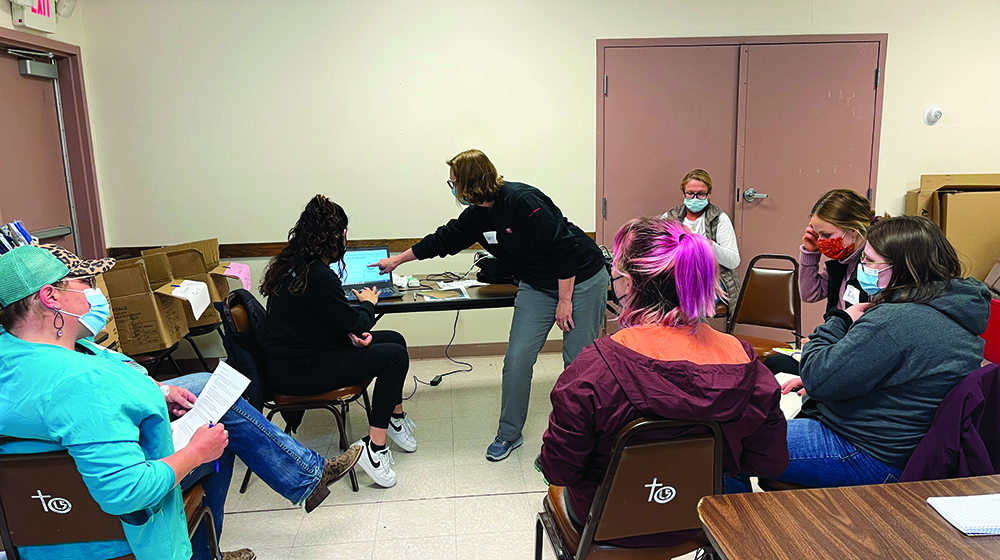Loyola University > School of Nursing > About > News and Events > Loyola Nursing Magazine > Loyola Nursing 2023 > Missions of care
Missions of care

Two service immersion programs extend Loyola Nursing’s reach
Stories by Emily Ayshford
Finding spiritual healing in Lourdes
In 1858 in Lourdes, France, a young girl had visions of the Virgin Mary, who told her to dig and drink from an underground spring. The site quickly became a destination for those seeking cures. Today, millions of religious pilgrims visit the site each year, where they wash themselves in stone baths and drink the water, hoping to find spiritual healing.
For a week in May, Loyola Nursing students volunteer in the baths, assisting the visitors and reflecting on what spiritual care means. This year was the 11th Lourdes Service Immersion. The school did not take students during the pandemic.
“It’s very important for our students to engage with sick people from around the world,” says Ann Solari-Twadell, the associate professor who leads Loyola Nursing’s Lourdes Service Immersion program. “At Loyola, care for the whole person includes physical, emotional, and spiritual wellbeing. For our students to have this experience is transformational for them and for their future nursing practice. For some patients, spiritual care is the most important care that you can provide for them.”
This year, Jorgia Connor, assistant dean of the BSN program, wondered if the trip could include a more personal connection. She suggested that her cousin Maureen Sevandal come along. Sevandal, a 44-year-old pediatric dentist with two young children, had just finished chemotherapy after her third recurrence of breast cancer in eight years and was searching for both physical and spiritual healing.
Sevandal agreed and met with the nursing students before the trip to share her story—something the normally reserved Sevandal struggled with. “I basically talked for the longest I’ve ever talked in my life,” she says. She told them of her struggles with the diagnoses, the treatments, and keeping up her roles as a dentist and a mother throughout. “I wanted to be more spiritual, and I told them this trip would help me do that,” she says.
The group joined her in a healing mass, and when they traveled to France and visited the baths, Connor assisted Sevandal as she washed herself in the waters, which Sevandal says felt like “a baptism and renewal of my spirit.”
“Having Jorgia and the nursing students there was very comforting,” Sevandal says. “I felt overwhelming love from the power of prayer and being in such a miraculous place. I wanted to show the nursing students the power of spiritual care, that even though this was not my plan, God has a purpose. And even in my struggles, I do have a lot of blessings in life.”
For Connor and the students, Sevandal’s story made their immersion experience that much more powerful. “The students are also seeking spiritual healing themselves, and they all said how special it was to have her with us,” says Connor. “That real personal connection shows them the power of spiritual healing, and that’s something they can take back with them and use as they become nurses.”

Treating patients in the rural, under-resourced environment of the Pine Ridge Reservation
On the Pine Ridge Reservation in the grasslands of South Dakota, the Oglala Lakota tribe lives and celebrates its heritage among its unique institutions, including within the Our Lady of the Sioux parish.
But the reservation is among the poorest in the country, and many residents struggle with alcohol and drug addiction. Its rural location also means its residents are underserved medically.
In 2018, Loyola Nursing students and faculty first traveled to the reservation for a week-long service immersion trip. They repeated the trip in 2019 but were unable to go in 2020 and 2021 due to COVID-19. Loyola Nursing returned to Pine Ridge in 2022 and this year.
There, they help however they can— cleaning, delivering food to residents, or painting buildings—while learning about Lakota culture and history, and what it means to provide care when resources are restricted.
“We meet with people from the community to hear about what life at Pine Ridge is like, then we provide service to the community,” says Ann Solari-Twadell, the associate professor who leads the Pine Ridge Reservation immersion programs. “The students develop realtionships within the community and get a perspective on what it's like for people trying to survive in this challenging geographic terrain.”
For nursing student Elizabeth Castillo, that meant meeting with parishioners at Our Lady of the Sioux. “The people were very open with their struggles,” she says. “Their community was important to them, but they didn’t want their children exposed to these issues. It made me realize how different it is from my own experience and made me want to be the kind of nurse who advocates for policy changes to help this.”
This year, thanks to a Health Resources and Services Administration (HRSA) grant, the students also had an opportunity to practice telehealth visits—a high-demand skill since the pandemic. The Interprofessional Rural Telehealth Certificate Program paired Loyola nursing students with social work students and medical students to simulate a telehealth visit on the reservation.
The telehealth simulation was designed to bring students together using equipment received during the pandemic from the federal CARES Act. This allowed all students and faculty to engage whether they went to Pine Ridge or not.
“Usually, nurses conduct physical assessment using all our senses, but if the patient is on the screen, we can’t touch them,” says Carol Kostovich, assistant dean of innovative educational strategies and simulation and project director of the HRSA grant. For telehealth visits, nurses need to be trained in interviewing skills and to guide patients to move their bodies so nurses can examine them thoroughly.
The telehealth visit at Pine Ridge involved a simulated patient with diabetes who developed a foot ulcer. The students connected with Loyola University Medical Center in Maywood, Illinois and worked with the wound care team—as well as nursing students who did not go on the trip—to diagnose and create a care plan for the patient.
“The feedback was very positive,” Kostovich says. “Chances are, after students graduate, they will be exposed in some format to telehealth, even if they don’t serve in rural communities.”
Though Loyola Nursing has developed relationships with the Indian Health Service and the nearby hospital, the goal is to create a clinical practicum experience for Loyola students to also treat patients on the reservation.
“Students learn about the culture, socioeconomic issues, and health issues, and the goal is to come into this new situation and be of service,” Solari-Twadell says. “But now that we have been there for five years, we want our students to experience even more and help residents in a new way.”